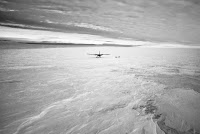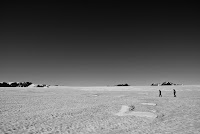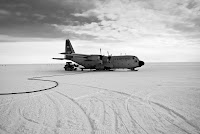This is a phrase that's been uttered countless times since I've gotten here, always by people who know. People who have lived here for ages. People who have stepped on bears and people who have walked away from multiple roll-over plane crashes.
It gives entirely new meaning to the phrase "that's ____!" I'm sure you've heard it. When invoked, it's part humorous, part smug, part implication that what you're hearing is insider knowledge, being coyly but knowingly shared between friends. Sometimes it's stated with an air of proud annoyance, as if to suggest that, yes, this particular aspect of [my state] is annoying, but in a unique way that I'll bet your sad, inexperienced, inferior state wouldn't know how to respond to. I've used the phrase, and I've probably heard it used in all the states in which I've spent any significant amount of time, but Alaska takes it to a whole new level.
__________
"People here are so nice!"
"That's Minnesota!"
The Saturday after I got into Fairbanks, I woke up at 5:00 am (this was okay, because I was still in Eastern time - it felt like 9:00) to go grocery shopping before catching my train at 8:00. I had purposely picked a motel close to a 24-hour grocery store so I could walk there, walk back, and repack all my stuff without budgeting for a taxi or extra transportation time.
After snoozing a couple times, showering, and repacking to make room for the incoming food in one of my checked bags, I ambled over to the Safeway at about 5:45 am, knowing I needed to be back to catch the train station shuttle at 7:00. Not knowing the layout of the grocery store, it took me a little while to find my way around. I also missed a few things the first time around, so by the time I got out (with almost 100 lbs of groceries and no cart), I was cutting it close with the 15 minutes I still had to walk back.
As I wobbled across the parking lot, I heard a honk coming from the adjacent Carl's Jr. I looked over and a couple guys in a Ford F-250 Super Duty were waving me over. They asked me if I needed a ride somewhere, and I motioned in the direction and mumbled something about it being out of their way (it was on a dead-end road). They said it was no problem - they had nothing to do anyway because the establishment to which they were taking the large contraption being towed on the back wasn't open yet. I hopped in and we started chatting, and five minutes later they dropped me off and helped me carry my groceries to the door. I gave them my thanks (they refused anything else), packed up, and headed to the train station.
I related this story to a few of my new coworkers in the park. "That's Alaska!" they said.
 |
| Even the graffiti is friendly! |
 |
| View down Healy Canyon toward the Alaska Range aboard the Alaska Railroad Denali Star |
__________
"Seeing a bear in the [Baxter State] Park is a rare treat!"
"That's Maine!"
At the end of my first week (last Thursday), the physical sciences group here at Denali took a trip over to the far west end of the park road, which is only paved and accessible to private vehicles for the first 15 miles. The trip served multiple purposes. We were headed to Kantishna, a small mining town that had enjoyed several booms over the course of the 20th century and that had been absorbed by the park in 1980 and was now a small community with no cell phone service, one road in (the park road), a grass airstrip, and a few very expensive lodges for people who wanted a comfortably hardcore wilderness experience and could afford it. A few of the buildings and camps that the park now uses as personnel stations in Kantishna are historic, dating back to the prosperous gold and antimony mining days. The park had repurposed one of these camps, Friday Creek, as a staff camp for people coming out to work on reclamation efforts on the numerous streams running through Kantishna. This camp is used relatively often because the streams run neon orange and are therefore a constant source of work and study, and it falls under the purview of the park geologist, so every year, he and the staff go there to set it up and spend some time up there.
 |
| A fragment of the physical science team pauses to discuss Moose Creek in Kantishna. Rocky, a lifted Ford F-350 Super Duty, looks on. |
The trip also serves as an introduction to the geology of the park. Much is visible from the park road, including formations, fossils, fault facets, and all manner of fun geological things. We stopped periodically to admire spectacular folds in the schist, colorful volcanics, and enormous glaciers. For us newbies, though, it was an even better opportunity for spotting wildlife. In my few short days at the park, I had already seen a bald eagle, a moose, caribou, marmots, pikas, ground squirrels, and mice. I was figuring we might see a large mammal or two on the trip up. My expectations were thoroughly surpassed with 10 grizzly bears (including three cubs), herds of caribou, golden eagles, and other smaller fare. All of this in about 8 hours.
 |
| A Toklat Grizzly (uniquely identifiable by their blonde coats) clambers up a slope near Polychrome Pass |
 |
| While another sleeps below the same cliff. It's adorable, but look at those claws... |
We got to camp, set up, and had some wonderful food. I met some other new folks and chatted with a few of my superiors well into the evening. There were only three of us left around the campfire when we decided to put it out and call it a night. It was still broad daylight, of course, but I still felt a little uneasy walking back to my cabin, which was down at the end of the road and semi-isolated. I was lucky enough to get the historic one in the camp. It had no power, water, or gas, but it was incredibly comfortable and well built. It had a little register where rangers and other park staff who had been out at that end of the road had written about their experiences. Generally, they corroborated with the signs plastered all over the walls that said "WARNING: BEARS FREQUENT THIS AREA AND HAVE ENTERED THIS CABIN AND KNOW IT MAY CONTAIN FOOD! IF POSSIBLE, STORE ALL FOOD AWAY FROM CABIN! KEEP FOOD IN BEAR-PROOF STORAGE!" The bear-proof storage was a 50-gallon drum under the sink that was sealed with a steel bar and multiple bolts. I was suitably unnerved by this, but slightly reassured after my boss told me they didn't
usually get into any mischief if humans were around. Just to be on the safe side, I built a fire in the cozy little fireplace in the cabin. I slept wonderfully.
"That's Alaska!"
 |
| My own little slice of bear-infested heaven! Couldn't really get a better view without disturbing the local wildlife. |
__________
"It was 65 degrees on Tuesday and now it's snowing!"
"That's Ohio!"
On Saturday we drove from the end of the park road back to HQ (a mere 92 miles away). Only five of us were left at the camp because we were working on a specific project on the way back that involved a lot of stopping and thinking and observing. We woke up and looked like it was going to be a beautiful day for field work. It was 65 degrees, sunny, and we were all well-rested and ready to go. As we drove away, it started to cloud over a bit, and stayed cloudy for the first 30 miles (about 2 hours). When we got out at Eielson Visitor Center to take a look at some volcanics and glacial features, it started to rain. We popped inside for a quick look around and came back out.
It was snowing. Hard. It started accumulating before we even left the parking lot. Thankfully we were in a monster of a truck, so even with slightly slick conditions on an unimproved road along sheer cliffs, we still felt reasonably safe. We limited our stops after that point, and by the time we got to Toklat at Mile 53, there was a substantial amount of snow on the ground. We stopped to eat lunch at the camp there, played some table tennis, and took Rocky out onto the river bed for a short demonstration of its abilities.
 |
| Snow falls in front of the Toklat ranger station |
We moved on and had made it another 10 miles before, abruptly, the snow stopped and the sun came out. 40 miles later, we were back at headquarters, shedding our down jackets and raincoats because it was back up to 65 degrees. The entire park road between headquarters and Kantishna is between 2000 and 4000 feet of elevation, so I couldn't really blame the weather on freakish highs and lows.
"That's just Alaska!"
 |
| The view of Divide Mountain (so named because it divides the east and west branches of the Toklat River) from the Toklat River bridge on a significantly less snowy day |
____________________
I've also done some phenomenal hiking since being here, but I'll save that for a hiking-themed post later on. Thanks for reading!













































